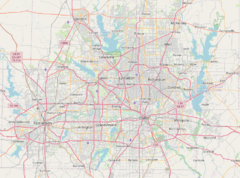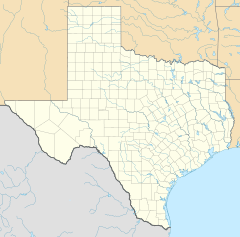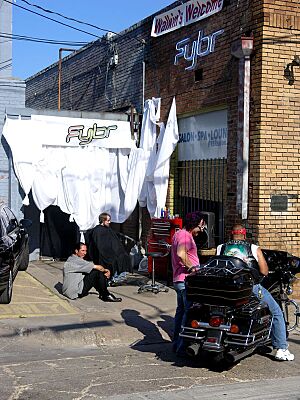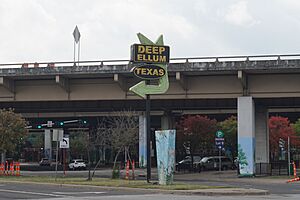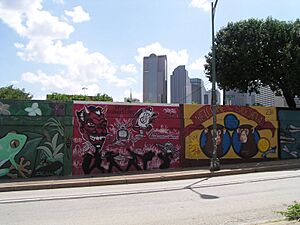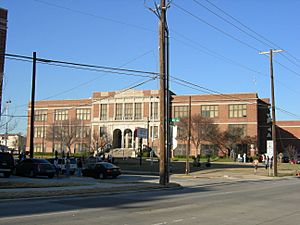Deep Ellum, Dallas facts for kids
Quick facts for kids
Deep Ellum
|
|
|---|---|
|
Neighborhood
|
|
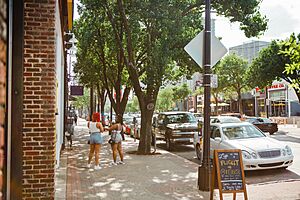
Main Street in Deep Ellum
|
|
| Country | United States of America |
| State | Texas |
| County | Dallas County |
| City | Dallas |
| Time zone | UTC-6:00 (CST) |
| • Summer (DST) | UTC-5:00 (CDT) |
Deep Ellum is a lively neighborhood in Dallas, Texas. It is known for its many art galleries, restaurants, bars, and entertainment spots. You can find it near downtown Dallas, in the area called East Dallas. The name "Deep Ellum" comes from how people used to say "Deep Elm Street," which is a main road there.
This neighborhood is just east of the I-45/US 75 freeway. It stretches to Exposition Avenue. Several streets like Pacific, Elm, Main, Commerce, and Canton connect it to downtown. Deep Ellum is north of Exposition Park and south of Bryan Place.
Contents
Deep Ellum's History
Early Development
Deep Ellum started in the late 1800s. It grew as a place where people lived and worked on the east side of downtown Dallas. At first, it was called Deep Elm. But locals often said "Deep Ellum," and that name stuck. Because it was close to the Houston and Texas Central railroad, people also called it Central Track.
Deep Ellum is one of Dallas's most important historical areas. It was one of the first business districts for African-Americans and European immigrants. The neighborhood has many old storefronts from the early 1900s. Many of its buildings are historically significant.
Industrial Growth
In 1888, Robert S. Munger built his first cotton gin factory here. It was called the Continental Gin Company. He built it with brick warehouses along Elm Street. As his business grew, it became the biggest maker of cotton-processing machines in the United States. Munger added more buildings in 1912 and 1914. This factory complex is now a Dallas Landmark. In 1997, it was turned into loft apartments.
In 1914, Henry Ford chose Deep Ellum for one of his first car factories. This building was designed to assemble the famous Ford Model T. The plant stayed at 2700 Canton Street until the mid-1930s. Later, in 1959, Adam Hats moved into the building. This Dallas Landmark was also converted into loft apartments in 1997. This gave the historic building a new purpose.
The Union Bankers Trust Building at 2551 Elm Street is another famous landmark. It was built in 1916 as the Knights of Pythias Temple. William Sydney Pittman, the state's first black architect, designed it. He was also the son-in-law of Booker T. Washington.
This temple was the state headquarters for the Knights of Pythias. It also had some of the first offices for black doctors, dentists, and lawyers in Dallas. It was a main social and cultural spot for the African-American community until the late 1930s. Other Dallas Landmarks in Deep Ellum include The Palace Shop (around 1913) and Parks Brothers Warehouse (around 1923).
Deep Ellum's Entertainment Scene
The 1990s were a great time for Deep Ellum's entertainment scene. By 1991, Deep Ellum had 57 bars and nightclubs. There were also restaurants, tattoo shops, and other unique stores. More and more people started living in high-rent loft apartments there. Famous places from the 1990s included Deep Ellum Live and Trees. The Angry Dog restaurant is still open today.
In 2011, the Deep Ellum Brewing Company opened. This microbrewery makes its own beers. It now sells its drinks to bars all over Texas. They also offer public tours.
Music in Deep Ellum
Jazz and Blues Roots
Deep Ellum is very famous for its music history. In the 1920s and 1930s, it was a hub for early jazz and blues musicians. Famous artists like Blind Lemon Jefferson, Blind Willie Johnson, and Robert Johnson played here. Others included Huddie "Lead Belly" Ledbetter and T-Bone Walker. These musicians performed on the streets and in clubs like The Harlem. Between 1920 and 1950, the number of nightclubs and cafes in Deep Ellum grew a lot.
In 1937, a writer described Deep Ellum as a place that never slept. It was a unique spot where business, religion, and entertainment all happened at once. You could find many different shops there. These included gun shops, clothing stores, and barber-shops. There were also pawn shops, drugstores, and pool halls. Around World War I, Lead Belly and Blind Lemon Jefferson even wrote songs about Dallas.
The most famous song about the area is "Deep Ellum Blues." The Lone Star Cowboys recorded it in 1933. This song was later performed by the Grateful Dead. Even Bob Dylan mentioned Deep Ellum in his 2020 song "Murder Most Foul."
After World War II, Deep Ellum's success began to fade. More people used cars, so the railroad tracks were removed. The streetcar line was also taken away by 1956. Businesses closed, and many residents moved away. The music scene quieted down. By the 1970s, only a few original businesses remained.
The New "Glory Days" (1983–1999)
In 1983, a plan was made to help Deep Ellum. The city wanted to keep its artistic and historic feel. They decided to control building height and population. Soon, artists, musicians, and business owners started moving in. They opened new art galleries and music venues. This brought a new energy to the area.
Deep Ellum became a major music spot again. Local bands like The Reverend Horton Heat and Three on a Hill played there. Other popular bands from nearby states also performed. Important music venues included Twilight Room, Adair's Saloon, and Club Dada. Young artists like Rhett Miller and Sara Hickman often played music for tips on the streets. Local radio stations even played songs from "Deep Ellum Bands."
By the 1990s, bands like Toadies, Erykah Badu, and Old 97's became famous. They were not just local stars but national ones. Older musicians like Ronnie Dawson (musician) also found new fans. Popular touring artists like Nirvana, Pearl Jam, and Red Hot Chili Peppers played shows at venues like Trees Dallas and The Bomb Factory.
Even though Deep Ellum's popularity changes over time, it remains an important music center for Dallas.
Street Art in Deep Ellum
Besides live music, Deep Ellum is known for its amazing street art. Many music venues used graffiti artists to advertise their shows.
In 1991, the city asked local artists to paint murals along the Good-Latimer Expressway tunnel. This project was called TunnelVisions. The tunnel was later taken down for the DART Green Line train. In 2009, artist Frank Campagna led new mural projects. These were along the redesigned Good-Latimer gateway. More murals were added under the I-30 overpass. These colorful, graffiti-style images are a popular attraction for visitors.
Many murals in Deep Ellum are created for local businesses. Frank Campagna, who owns Kettle Art Gallery, is known as the "Godfather of Dallas Street Art." He has created murals for famous music venues like Gypsy Tea Room and Trees. Recently, the "42 mural project" invited artists to paint murals. This project aimed to share the history of Deep Ellum. In 2021, a huge 8,500 square foot mural was finished for The Stack office building. It is one of the largest murals ever painted in Deep Ellum.
Getting Around Deep Ellum
Highways
 Interstate 345 (connects to
Interstate 345 (connects to  US 75 and
US 75 and  I-45)
I-45)
Trains
- DART Green Line
- Deep Ellum Station
- Baylor University Medical Center Station
Education
The Dallas Independent School District serves Deep Ellum.
Students living north of Commerce Street go to Ignacio Zaragoza Elementary, Alex W. Spence Middle, and North Dallas High School. Those south of Commerce Street attend Martin Luther King Jr. Learning Center (Elementary), Billy Earl Dade Middle, and James Madison High School.
Deep Ellum also has a charter school, Uplift Luna Preparatory. It opened in 2010 and is known as a high-performing school.


